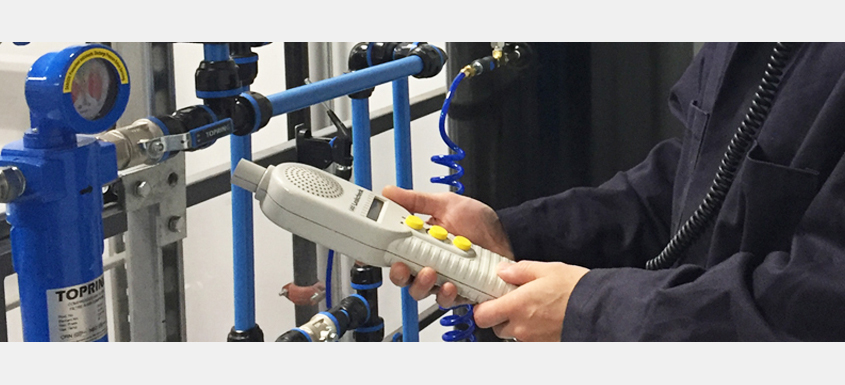Do you let your faucets run? No. Well, the same should apply to your compressed air piping system. However, unlike water or oil leaks, air leaks are invisible and won’t cause damage... but they're just as costly! So what should you do? Be proactive: start a leak detection program and keep it up.
How to tell when compressed air is leaking
Can you tell if there are air leaks in your compressed air piping system? If you notice any of the following at your plant, it’s time to take action.
- The compressor starts up even though all tools and equipment are turned off (this is easier to notice at night)
- The system shows pressure loss at various locations or at one specific location in the system
- Pneumatic tools or equipment don’t get enough air while in use
- You hear hissing, which is the sound of air escaping (leaks can be loud enough to hear)
What leaks can cost you
It all starts with one or two tiny leaks that are imperceptible at first. Then more leaks appear, or existing ones get bigger. Finally, the many accumulated leaks not only undermine the efficiency and productivity of the entire system, but also lead to high energy bills.
With compressed air costing close to $0.25/1000 ft3 ($0.08/kWh), an average plant can save plenty just by setting up a leak detection and repair program. Every leak has a cost. That’s why you need to act—and quickly.
Air Leaks and Compressor Power Consumption ($/year)
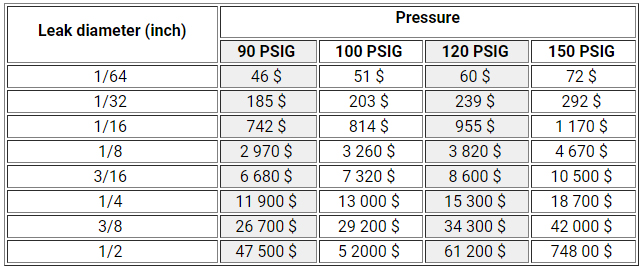 This table shows how much leaks can cost based on leak diameter and pressure. The calculations are based on 8,760 hours of operation with a 100% effective compressor.
This table shows how much leaks can cost based on leak diameter and pressure. The calculations are based on 8,760 hours of operation with a 100% effective compressor.
Read our case study Energy Efficiency In Compressed Air:Regitex for a concrete example of how you can save just by setting up a leak detection and repair program.
“We knew we had air leaks in our compressed air system, but we had no idea how big the problem was! With a leak detection program, we discovered that our leaks were costing us $22,251 a year.” – G. Demers, Regitex Case Study.
Eliminate unwanted compressor starts with a programmable ball valve
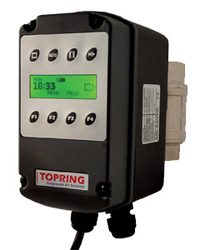 An AIR-SAVER® programmable ball valve isolates the compressed air system from the compressor and reduces air loss when the system is inactive. Among other benefits, this prevents the system from unnecessarily starting up overnight when an air leak triggers a demand for air. Although it doesn’t eliminate air leaks, it does reduce power bills that have crept up due to leaks.
An AIR-SAVER® programmable ball valve isolates the compressed air system from the compressor and reduces air loss when the system is inactive. Among other benefits, this prevents the system from unnecessarily starting up overnight when an air leak triggers a demand for air. Although it doesn’t eliminate air leaks, it does reduce power bills that have crept up due to leaks.
> Learn more about the S65 AIR-SAVER® Programmable Ball Valve
Leak detection programs
A leak detection and repair program begins with an audit of your compressed air system. This is the most direct way to determine the status of your system and:
- Get an idea of overall air loss
- Identify critical locations where air is being lost
- Estimate what the leaks are costing you
- Take the required actions based on your priorities
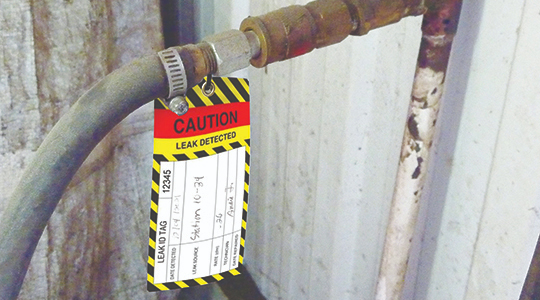 There are different ways to identify compressed air leaks. Once found, mark each leak with an identification tag. This lets you keep track of their location, monitor them closely and repair them in a timely manner.
There are different ways to identify compressed air leaks. Once found, mark each leak with an identification tag. This lets you keep track of their location, monitor them closely and repair them in a timely manner.
Tip: Print a copy of the Appendix – Air Leak Report on page 9 of our white paper titled3-Step Maintenance Control for Compressed Air Piping Systems to record each leak and determine its level of severity. The next step is to set repair priorities.
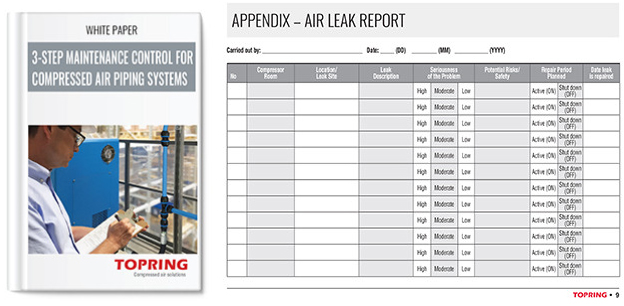
Methods of leak detection
1. Ultrasonic meters
Ultrasonic meters are highly effective for measuring compressed air leaks, especially at heights (up to 20 meters). This method is very accurate and should be favored whenever possible. Hire experts who specialize in leak detection. Contact a Topring Technical Advisor to learn more about this effective method of detecting air leaks. We can help you with the process.
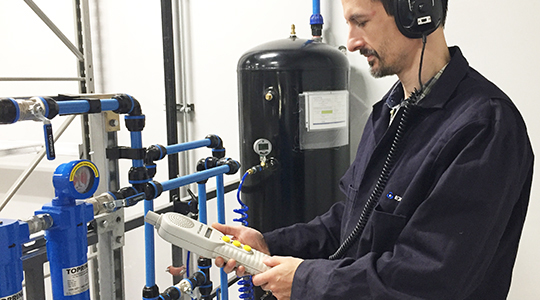 Using an ultrasonic meter to detect compressed air leaks.
Using an ultrasonic meter to detect compressed air leaks.
2. Inspection outside operating hours
A fairly simple way to detect air leaks is to listen when the compressed air system is off. You’ll be able to hear the air leaks and then feel them through touch. Of course, this may only work for fairly big leaks, and you have to be close enough to the air system to touch it.
3. Soapy water
You've probably heard of using a spray bottle filled with mild soapy water before. It’s a cheap and easy way to find leaks. Just spray soapy water at the system connections. Soap bubbles will form at critical points, showing you where the leaks are.
Caution: Be careful! There are often electrical wires near a compressed air system. For safety reasons, some plants prohibit this method. In this case, choose another way to detect leaks.
 Soapy water is used to identify compressed air leaks, which are then marked with a red tag.
Soapy water is used to identify compressed air leaks, which are then marked with a red tag.
System maintenance and repair
You know your compressed air system better than anyone. Regular maintenance of the components in that system will keep it operating efficiently. Maintenance frequency needs to reflect the conditions of use.
Detecting air leaks is an important step in the maintenance process for compressed air systems. And fixing those air leaks is just as important, if not more! Unfortunately, companies often invest in a leak detection program, then never take action. Make a long-term plan and stick to it: repair the most critical points first, followed by the least critical ones.
A few examples of maintenance operations:
- Applying a thread sealant to eliminate leaks
- Replacing filters
- Tightening any loose fittings
- Replacing faulty quick couplers, hoses and air tools
Download our white paper 3-Step Maintenance Control for Compressed Air Piping Systems to discover our simple, effective method of air system maintenance.
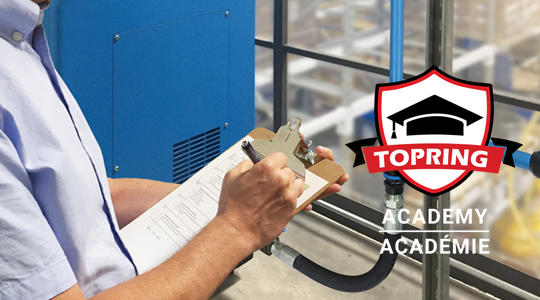
Find out about our free training Compressed Air System Maintenance (Maintenance d’un systèmed’aircomprimé) with Topring Academy. Learn more about how you can improve the efficiency and performance of pneumatic tools and equipment, as well as how you can eliminate compressed air leaks.
Turnkey service
Contact a Topring Technical Advisor to start a compressed air leak detection and repair program.
✉
Source: Topring



